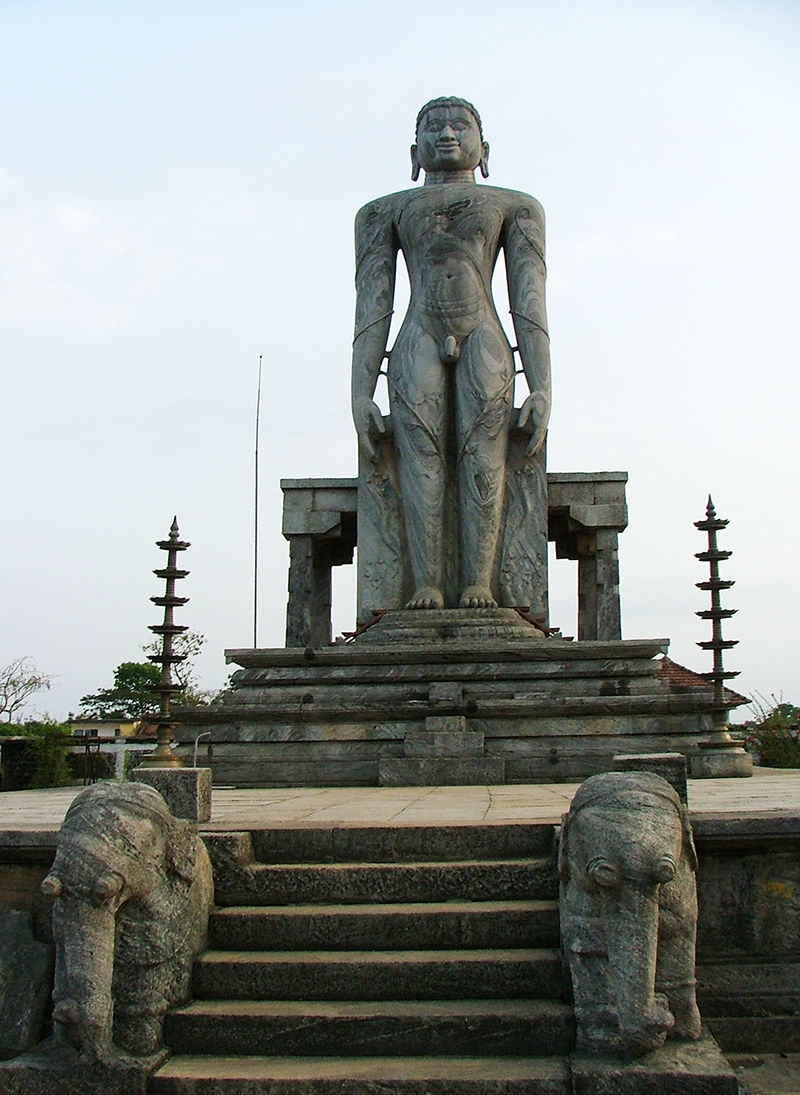A nearly twelve-metre tall monolith, the Gomateshvara Statue in Venur is one of the five such statues of the deified Jain figure Bahubali in present-day Karnataka, India. Completed in 1604 CE, it was commissioned by Vira Timmaraja — an important chieftain of the Ajila dynasty, which ruled Venur for over six centuries. It is believed by locals to have been carved by Amarashilpi Jakanachari, which was possibly a guild of artisans operating under a pseudonym. Given the historical prevalence of Jainism in the region, Bahubali (whose name translates as “the one with strong arms”), also known as Gommata or Gomateshvara, is richly featured in the literature, legends, and living traditions of Karnataka. Other prominent monolithic Gomateshvara statues in Karnataka include the ones at Shravanabelagola, Karkala, Dharmasthala and Gommatagiri — popular Jain pilgrimage sites alongside Venur.
Placed on a high pedestal, this statue shows Bahubali standing upright in the kayotsarga, or motionless position and facing westward. Eyes closed in meditation, he is depicted with long ears, tight curls of hair, and arms hanging by the sides and nearly reaching down to the knees. The mouth is shown slightly smiling and the neck is carved with three superficial folds, as is the abdomen. The shoulders are wide, the waist narrow, and the legs slightly apart. While the figure is completely nude — as typical in the Digambara Jain traditions — vines and anthills are depicted climbing over his arms and legs.
The imagery relates to the description of Bahubali’s life in the Adipurana of Pampa, a Kannada epic composed in the tenth century in the court of a feudatory of the Rashtrakuta Dynasty. Bahubali is believed to be one of the hundred sons of Rishabhadeva, the first Jain tirthankara. According to the narrative, Rishabhadeva and all of his sons, with the exception of Bahubali, give up their kingdoms in favour of the eldest son, Bharata. Various contests of power ensue between the two brothers, both said to have immense strength, with Bahubali defeating Bharata in all of them. About to vanquish Bharata in the final fight, Bahubali is overcome by disillusionment with worldly power and remorse at humiliating his own brother. Renouncing his kingdom and all worldly possessions, he retreats into the forest, where he is said to have stood in one place in the kayotsarga position seeking spiritual liberation. At the end of a year of motionless meditation, during which plants, insects, snakes and other creatures climb over his limbs and nest in his hair, he is believed to have been visited by Bharata who came to worship him. This releases him from his lingering guilt and he achieves omniscience or kevala. Some scholars also mention a visit from his sisters Brahmi and Sundari, who urge him to let go of his pride and remorse, as the turning point in his meditation.
This narrative is central in Bahubali iconography, with the earliest known image found in Cave 4 at Badami, dated to the late sixth century. Visual representations of him, especially with vines, remained consistent in the Deccan through the next few centuries, and the only variance seen is in the depiction of his hair, which appears as long, flowing locks in earlier images such as the one at Badami. Motifs like the anthill and depiction of attendant women figures with Bahubali images gained prevalence between the tenth and the fourteenth century, particularly during the reign of the Hoysala dynasty.
Bahubali, an arihant, is represented in earlier traditions alongside Parshvanatha, the twenty-third tirthankara. It is only gradually that he came to be represented individually in colossal monolithic statues. The origins of these statues are not entirely clear: they may be linked to highly public abhishekam associated with Jain idols in the early mediaeval Deccan. The date of the Adipurana also suggests that the Bahubali cult was increasingly popular with royal families from the tenth century onwards.
Today, the popularity of Jainism has faded in inland Deccan but statues of Bahubali continue to be worshipped by local communities. Every twelve years, a consecration ceremony called Mahamastakabhisheka takes place at the five major sites in Karnataka. Sacramental substances such as sugarcane juice, milk, coconut water, sandalwood, vermillion and turmeric are carried in pots to the top of the statue and poured over its head. The ceremony is known to be densely attended, not only by locals and Jains but people of various faiths who travel to observe it. At Venur, however, as of writing, the ceremony has only been held four times in the past century: in 1928, 1956, 2000 and 2012.







